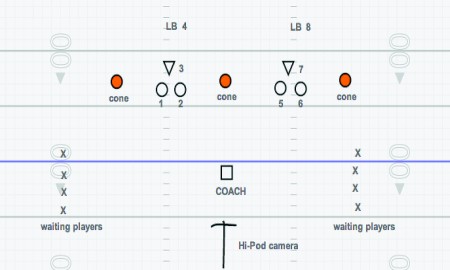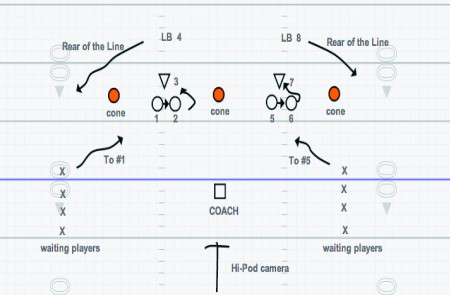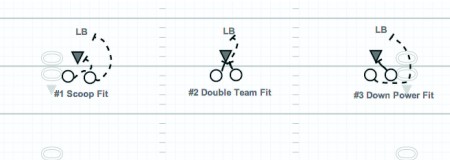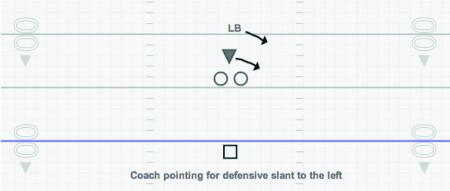Article CategoriesAFM Magazine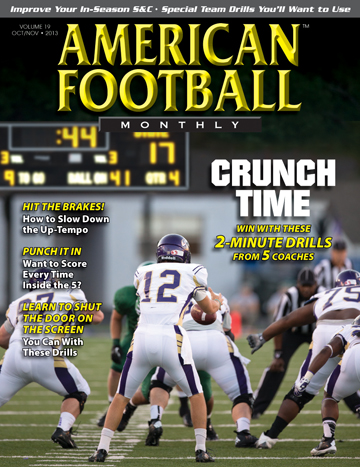
|
Drills Report: The Reach Doug Down Drillby: Bill HoltOffensive Line Coach Elizabeth City State University © More from this issue I believe that the most important element of our football team is our offensive line. This is not to demean the other positions, but it is what I believe and preach to our players. If the defense gives up 50, then we must score 51. We will not score 51 points if we do not get it done up front. That means a hat on a hat at all times. We know that we will not always have the most gifted skill guys on the field and our quarterbacks might not always make the best decisions, but we can never be mediocre with our O-line play if we hope to have a chance to win. That means when we practice, we must have game-type movement and machine gun reps. You do not get your players better when they are standing around killing grass. A favorite drill that we try to use on our heavy days, which are usually Tuesday and Thursday, is the Reach Doug Down Drill. The “Reach” part of the drill involves the stretch technique while “Doug” refers to our double team drill and linebacker fit, and “Down” refers to the power pull in the drill. This drill works multiple techniques with a high number of reps. We try to have 20 reps in 10 minutes. We will make the calls to the O-line and point to the defense for slant and flow direction. Our initial alignment looks like a two-group drill but it is actually all the same drill. We will number all participants so that after the third rep, we will automatically rotate to the right and highest number (Diagrams 1 and 2).
Diagram 1.
Diagram 2. The three reps that we want to simulate before we rotate are # 1 - Scoop fit to LB (zone). #2 – double team fit on scrapping backer, and #3 – down block on LB (power) – Diagram 3.
Diagram 3. We make our calls by the coach with the OL all going the same way. We have three numbers that will indicate the play, even to the right and odd to the left. For example, if we go “10”, we will run zone right, executing scoop fit. “11” would be zone left. We use “14” for our double team and fit with a point to the backer on the side. We want the LB to play downhill. “13” would be to the left. For our last technique, we will call “16” to the right for our down power series and “15” to the left. We may point to the defense to give them a direction indicator which simulates slant or blitz. If we do not give a blitz call to the LB, we ask him to count 1001 before he fills the gap. If we point to the right we want a slant left dog left with the defense (Diagram 4).
Diagram 4. We then want our defense to go the opposite way. This drill is used with OL players only, but you can substitute scout team defensive players, if they are available. The cadence is set hut and then we are off. There should be no stoppage or coaching in this drill, as corrections should be made off of video in segment meetings. Work hard on high reps and simulate game speed. Make sure that there are no technique corrections and there is no drill stoppage. Time and reps are the most important elements of this drill. During the reach part of this drill make sure that both players execute a good fit with shoulder pads parallel to the LOS and eyes up. We want to secure the first defender, but always have the eyes on the triangle to find the second level threat. We teach the octopus concept, where, as we step, we feel the threat, then engage. Make sure that the players executing the calls are playing as a tandem, or unit, and not just concerned with their individual responsibilities. It is important that we keep our pad level down, especially on double teams, which is the “Doug” call. We want to win the leverage battle at all times and usually the player with lower pads wins. Our players will step with their inside foot, punch the sternum of the defender with the inside arm, and lock the inside part of the shoulder pads to get a tight fit. Eyes and head should be up. Have your players On the power phase, we want to get a hard step with the inside foot to the 3-tech or gap defender, securing the gap and not allowing any penetration by the defender. The power pull player executes a power step technique and blocks the first defender that shows in what we call the “tunnel.” If a “train” is in the tunnel, we block the train. If there is daylight in the tunnel, we go through it and start looking for the first threat inside out. This drill is highly usable on not only heavy days but also on thud days. |
|
| HOME |
MAGAZINE |
SUBSCRIBE | ONLINE COLUMNISTS | COACHING VIDEOS |
Copyright 2025, AmericanFootballMonthly.com
All Rights Reserved


